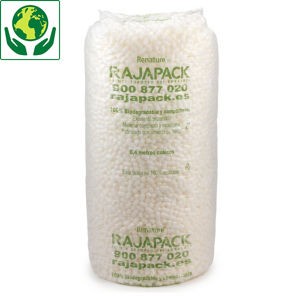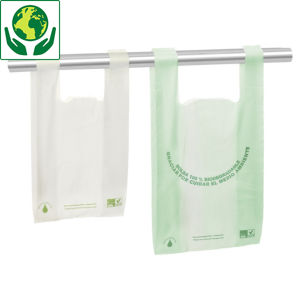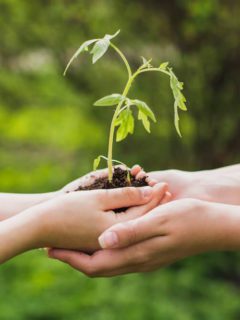In our efforts to be increasingly eco-responsible, one of the objectives we have set ourselves at RAJA® is to select environmentally friendly materials for the manufacture of our packaging: recycled cardboard and paper, regenerated plastic, reusable raffia and cotton… and, of course, different types of biodegradable plastics, suitable for the manufacture of bags or filling chips.
Biodegradable plastics are an increasingly important subset of the polymer industry. Do you know what their characteristics and advantages are? Do you know their different origins? If your answer is no… just read on!
what are biodegradable plastics?
Biodegradable plastics are different from other plastics because, under certain conditions of temperature and humidity, they are consumed by microorganisms and enter an oxidation process that favours their conversion into water, carbon dioxide and biomass, thus reintegrating into the carbon cycle without leaving residues.
Unlike biodegradable plastics, conventional plastics only degrade under the action of the sun’s ultraviolet rays and, over time, break down into small particles, microplastics, which do not undergo any change in composition and therefore cannot be digested by living organisms.

Classification of biodegradable plastics
Biodegradable plastics are classified into different categories according to their origin and whether they can be composted or not.
a) By origin
- Biodegradable plastics of fossil origin.
- Biodegradable plastics of biological origin, or bioplastics.
b) By compostability
- Non-compostable biodegradable plastics.
- BioCom plastics which, according to the Spanish Association of Biodegradable Compostable Plastics (Asobiocom), are defined as plastics of vegetable origin (corn, wheat, potato, cassava, peas…), partially vegetable or synthetic that are biodegradable and compostable.
how long do biodegradable plastics take to decompose?
The decomposition process of biodegradable plastics is not only environmentally friendly, but also has another advantage: it is much faster than that of conventional plastic resins.
Biodegradable plastics are generally fit for use for about 18 months from the date of manufacture, after which they require between one and a half and three years to disappear and be absorbed by nature.
However, despite their positive implications, the use of biodegradable plastics in the manufacture of packaging creates a problem. Bioplastics cannot be mixed with conventional plastics for recycling, or this would make it impossible to recover the whole batch. When sorting waste, organic plastics should go on one side and non-biodegradable plastics on the other.

Types of biodegradable plastics in packaging
Different types of biodegradable plastics are available for the manufacture of packaging:
Types of biodegradable plastics of synthetic origin
- PBS (polybutylene succinate), ideal for bottles, trays and various packaging solutions.
- PES (polyethersulfone): Hydrophilic material widely used in the food and pharmaceutical industry.
- PBAT (polybutylene terephthalate adipate). With good heat tolerance, it is characterised by its flexibility and transparency.
- PCL (polycaprolactone) – very tough, recommended for making films.
- TPS (thermoplastic starch), a mixture of polyesters with starches from different plants.
Types of biodegradable plastics of biological origin
- PLA (polylactic acid), a derivative of lactic acid made from 100% renewable raw materials, suitable for the manufacture of containers and packaging that will come into contact with foodstuffs.
- PHA (polyhydroxyalkanoates), derived from bacterial fermentation of vegetable raw materials, used in caps and bags.
- Starch-based bioplastics. More fragile than the previous ones, their great advantage is that they will degrade more quickly, but it must be borne in mind that they are water-soluble.
- Cellulose-based bioplastics: rigid and highly resistant, they are used for the production of labels and caps.
RAJA®’s commitment to biodegradable plastics
Always at the forefront of environmental care, RAJA®has already incorporated different types of biodegradable plastics into its packaging catalogue. Two examples of products made with these compounds are:
- Renature filling chips, made from corn starch, 100% recyclable, biodegradable and compostable, are very spongy and ideal for protecting fragile and delicate objects.
- The 100% biodegradable plastic bags with handles, made from cereal starch.
You too can join RAJA®’s crusade for a greener world. Check out our selection of EcoResponsible packaging and renew your brand’s packaging to adapt it to the demands of consumers who are increasingly aware of the value of sustainability. With RAJA® you will achieve it!
















